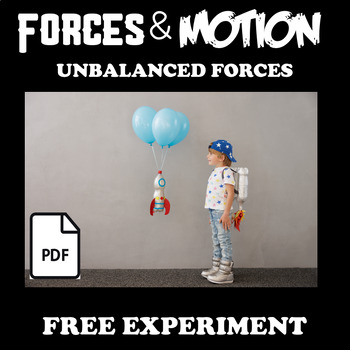- PDF
Description
Introducing our exciting and free forces and motion balloon experiment tailored for third-grade learners! Aligned with NGSS standards 3-PS2-1, 3-PS2-2, 3-PS2-3, and 3-PS2-4, this engaging activity dives deep into the realm of forces and motion. Explore the concept of unbalanced forces with this hands-on experiment designed to propel understanding.
Students get: informational text, data log sheet, success criteria, and guided notes.
This experiment serves as a fantastic resource to introduce young minds to the basics of forces and motion, using a balloon rocket to demonstrate key scientific principles. Students will learn about the impact of varying balloon sizes and added weight on the rocket's distance traveled, fostering an understanding of cause and effect, stability, and the interplay between forces. Each page includes clear instructions, informative text, a data log sheet, success criteria, and NGSS standards, ensuring a comprehensive learning experience. Delve into the world of forces and motion with this fantastic, free third-grade experiment!
Teaching Duration: Single Class Period is usually enough
Student Profile: Experiment works for the 2nd, 3rd, and 4th grade. It was created with third grade in mind.
☆ Standards: 3-PS2-1, 3-PS2-2, 3-PS2-3, 3-PS2-4, PS2.A: Forces and Motion, PS2.B: Types of Interactions. Crosscutting Concepts: Patterns of change can be used to make a prediction. Cause and Effect: relationships are routinely identified, tested, and used to explain change. ⋆·˚ ༘ *
Also complies with TEKS.SCI.3.2.D TEKS.SCI.3.2.B TEKS.SCI.3.2.C TEKS.SCI.3.2.F TEKS.SCI.3.2.E t
─────────────────
┊ ┊ ┊⋆。 ┊ ┊ ┊ ┊
┊ ⋆。 ┊ ┊ ┊ ┊⋆。┊ ༊*·˚
┊ ┊ ┊ ┊ ┊ ┊
┊ ‧₊ ༉ ┊ ˚✩ ┊ ๑՞.
┊ ₊˚.༄ ┊
✩₊̣̇. ੈ♡˳
✧.*ೃ༄
⋆·˚ ༘ * After Download You Will Also Get our Special Relativity Experiment for FREE! -- just sign up for the email list and the second experiment will be in your inbox. It will be of equal quality to this Balloon Rocket Experiment.⋆·˚ ༘ *
This experiment is one of six (6) experiments from our Forces and Motion Workbook. If you like this Free experiment, then you will certainly get a great benefit from our workbook.





